Linux Wi-Fi open source drivers
-mac80211, ath9k/ath5k-
Daniel Camps Mur
�
1. General Driver Overview
hostapd
wpa_supplicant
�
1. Transmission Path: kernelmac80211ath9k
Kernel hands the packet to the virtual interface
ieee80211_subif_start_xmit (tx.c):
-Adds the 802.11 header.
-Initializes transmission time in devtrans_start
ieee80211_xmit (tx.c):
-Makes headroom for encryption
struct ieee80211_local:
-This struct contains information about the real
hardware, and is created when the interface is first added
(ieee80211_register_hw() in main.c)
- This data structure is created from the structure
ieee80211_hw in mac80211.h
-This data structure probably allows the hardware driver
to register with mac80211 the proper function to be
called by drv_tx().
- The driver and mac80211 communicate through this
structure.
ieee80211_set_qos_header (wme.c):
-Sets TID in Wi-Fi header according to
skbpriority
ieee80211_tx (tx.c):
-Obtains the proper transmission queue.
-Prepares transmission
-If the packet can not be transmitted, it is
queued timestamp queue entry.
-Queues are maintained per sub-interface, in
the structure qdata[4] in
ieee80211_sub_if_data
-Calls drv_tx() to pass the frame to the actual
driver for transmission
drv_tx() (driver-ops.h):
-This is the entry point to the actual driver!
-It is called for each packet to be transmitted.
-Receives struct ieee80211_local
-Receives the sk_buff (the data)
skb_get_queue_mapping (?.c):
ieee80211_tx_prepare (tx.c):
invoke_tx_handlers(tx.c):
-In an AP checks if the data has to be to be
buffered
-Many other stuff …
struct qdata(ieee80211_i.h):
-enqueued
-max_enqueued
-ewma tserv_ns_avg (can this be useful?)
�
1a. Transmission Path: ath9khardware
drv_tx() in mac80211
ath9k_tx() (main.c):
-Loads details of the hardware in struct
ath_softc.
-Updates the PM bit (not set by mac80211).
-Wakes up hardware if it was sleeping.
-Uses data struct ath_tx_control to track the
status of the transmission
-Starts transmission in ath_tx_start()
ath_tx_start() (xmit.c):
-Receives a pointer to an struct
ath_tx_control containing a pointer to the
queue that contains the frame?
-If the destination is HT capable tries
aggregation.
ath_tx_send_ampdu() (xmit.c):
-The ath9k driver registers the functions to interface with mac80211 in struct
ieee80211_ops ath9k_ops. The input of this struct is then loaded in mac80211 using the
function ieee80211_alloc_hw() in main.c of mac80211.
- The function interfacing with drv_tx() is ath9k_tx()
-The common data also contains other info like the number of hw queues
ath9k_ps_wakeup() (x.c):
struct ath_softc (ath9k.h):
struct ieee80211_hw *hw;
struct device *dev;
bool ps_enabled;
struct ath_config config;
struct ath_rx rx;
struct ath_tx tx;
struct ath_beacon beacon;
struct ath_tx (ath9k.h):
struct ath_txq txq[ATH9K_NUM_TX_QUEUES];
struct ath_txq *txq_map[WME_NUM_AC];
-Contains the hw transmission queues. Ath9k has
10 hw tx queues.
-Points to the mac80211 tx queues
struct ath_txq(ath9k.h):
-Contains the equivalent mac80211 queue
-Contains the hw queue number
-Actual queue.
ath_tx_send_normal() (xmit.c):
-Receives as argument a txq
-Selects the data rate
-Adds the data to be transmitted in the txq ath_tx_txqaddbuf
ath_tx_txqaddbuf() (xmit.c):
-Receives as parameter a txq, then inserts the frame into the outbound
list, and sends it out to the hardware. The hardware physical queues
seem to support only 8 frames!
-If the packet can not be inserted in the physical queue then it is held
here.
ath9k_hw_txstart() (mac.c):
-Writes the proper register in the hardware to trigger the transmission
in a given queue.
-The hardware is the one performing the CSMA-CA according to the
configured parameters on that queue.
�
1b. Transmission Path: ath5khardware
drv_tx() in mac80211
-The ath5k driver registers the functions to interface with mac80211 in struct
ieee80211_ops ath5k_hw_ops in mac80211-ops.c. The input of this struct is then loaded
in mac80211 using the function ieee80211_alloc_hw() in main.c of mac80211.
- The function interfacing with drv_tx() is ath5k_tx() in mac80211-ops.c
ath5k_tx() in mac80211-ops.c
-Receives the skb to be transmitted.
-Finds the appropriate hw queue for that skb
ath5k_tx_queue() in base.c
-If the queue is already at its maximum size (max is 50 pkts) it
sends a signal back to mac80211 so that this stops his queues
(ieee80211_stop_queue). It also may drop the packet
-Copies the data to be transmitted in the txqueues. struct
ath5k_buf represents a single queued frame (buffer).
ath5k_tasklet_tx() in base.c
-Tasklet that is called when the following interrupts
happen: AR5K_INT_TXOK, AR5K_INT_TXDESC,
AR5K_INT_TXERR, AR5K_INT_TXEOL
ath5k_tx_processq() in base.c
ieee80211_stop_queue() in ?
ath5k_tx_frame_completed() in base.c
-Check a timestamp here ?
ath5k_txbuf_setup() in base.c
-Obtains data rate for this transmission
-Prepare for transmission
ah_setup_tx_desc() in desc.c
ath5k_hw_setup_mrr_tx_desc() in desc.c
Ieee80211_tx_status() iin mac80211
ath5k_hw_start_tx_dma() in dma.c
-Starts a transmission in the hw.
-My understanding is that the hw may already be trying to
transmit other frames that were previously submitted.
AR5K_REG_WRITE_Q() in dma.c
-Writes a certain register in the hw, so that the
transmission on a certain queue starts
�
1a. Reception Path: hardwareath9k
When receiving a packet, and also for other reasons, the
hardware sends an interruption that ath9k has previously
registered. The function in charge of handling the
interruption seems to be irqreturn_t ath_isr in main.c. This
function discovers the type of interruption and asks the
kernel to schedule the execution of a tasklet,
ath9k_tasklet in main.c. This function in turn calls the the
receive tasklet ath_rx_tasklet()
struct ieee80211_hdr (include/linux/ieee80211.h)
struct ieee80211_rx_status (mac80211.h)
u64 mactime : value in microseconds of the
64-bit Time Synchronization Function (TSF)
timer when the first data symbol (MPDU)
arrived at the hardware.
enum ieee80211_band band;
int rate_idx;
unsigned int rx_flags; …
ath_rx_tasklet (recv.c)
-Obtains the frame header
-Obtains the current tsf value
-Records info about received packet in struct
ieee80211_rx_status
-Insert received data in the receive buffer
-Creates a new skb to contain the received data
-Passes the skb to ieee80211_rx()
-Can we compute the airtime duration of the received
frame in this function, as “airtime = tsf - rxs->mactime” ?
ath9k_rx_skb_preprocess (recv.c)
-Checks if the received data has CRC errors
and in that case drops it. However, crypto
errors are still passed up to mac80211
-Populates ath_rx_status
ath9k_rx_skb_postprocess (recv.c)
-Remove padding from the received header
struct ath_rx_status (mac.h)
u32 rs_tstamp; This is given by the
hardware and eventually carried on to
mactime in ieee80211_rx_status
u16 rs_datalen;
u8 rs_status;
u8 rs_phyerr;
int8_t rs_rssi;
u8 rs_keyix;
u8 rs_rate;
u8 rs_antenna;
…
ieee80211_rx() (mac80211 rx.c)
-This is the entry point to mac80211
�
1b. Reception Path: hardwareath5k
ath5k_tasklet_rx in base.c
-Receives the interruption that a new
frame has been received
ath5k_receive_frame_ok in base.c
ath5k_receive_frame in base.c
- rxs->mactime contains the time the first bit
was received in the air
ieee80211_rx() (mac80211 rx.c)
-This is the entry point to mac80211
�
1. Reception Path: mac80211kernel
ieee80211_rx() (mac80211 rx.c)
-Removes the radiotap header
-Parses QoS from header.
-Decides if this packet is addressed to this
interface or to another STA in the BSS
-Calls ieee80211_prepare_and_rx_handle()
ieee80211_prepare_and_rx_handle()
-Receives as input an ieee80211_rx_data
-Calls the rx handlers
ieee80211_rx_handlers(rx.c)
-Among other calls the following functions:
ieee80211_rx_h_decrypt
ieee80211_rx_h_check_more_data
ieee80211_rx_h_sta_process
ieee80211_rx_h_data
ieee80211_rx_h_ctrl
…
ieee80211_parse_qos() (x.c):
struct ieee80211_rx_data (ieee80211_i.h)
struct sk_buff *skb;
struct ieee80211_local *local;
struct ieee80211_sub_if_data *sdata;
struct sta_info *sta;
struct ieee80211_key *key;
int queue ….
ieee80211_rx_h_sta_process() (rx.c):
-Updates the sta_info struct that contains
information about this station
ieee80211_rx_h_data() (rx.c):
-Removes the 802.11 header and passes
up the 802.3 frame
struct sta_info (sta_info.h):
-Info about this station, like:
-TX and RX statistics
-PS buffers if we are an AP
struct ieee80211_sta sta;
ieee80211_deliver_skb() (rx.c):
-Receives a frame with an Ethernet header
-Decides if the frame has to go up to the stack, or
must be reflected back to the wireless medium
(if we are an AP).
netif_receive_skb() (x.c):
-Delivers the skb to the local stack (kernel)
dev_queue_xmit() (x.c):
-Resends the skb to the wireless medium
�
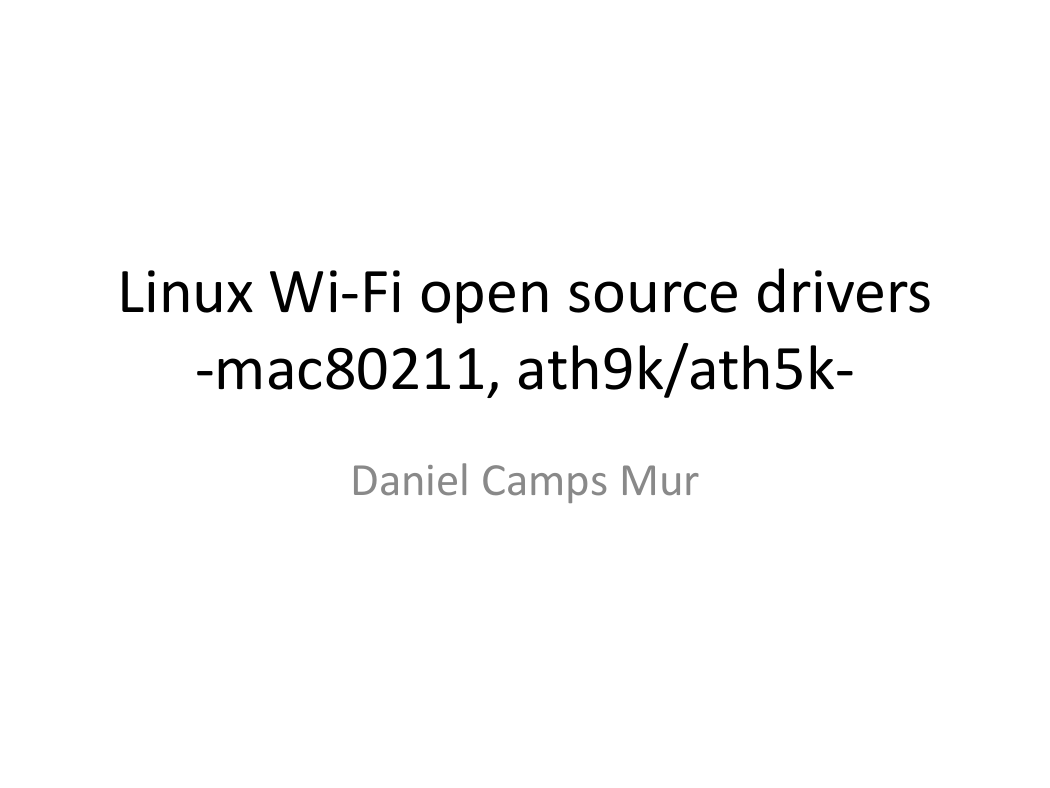

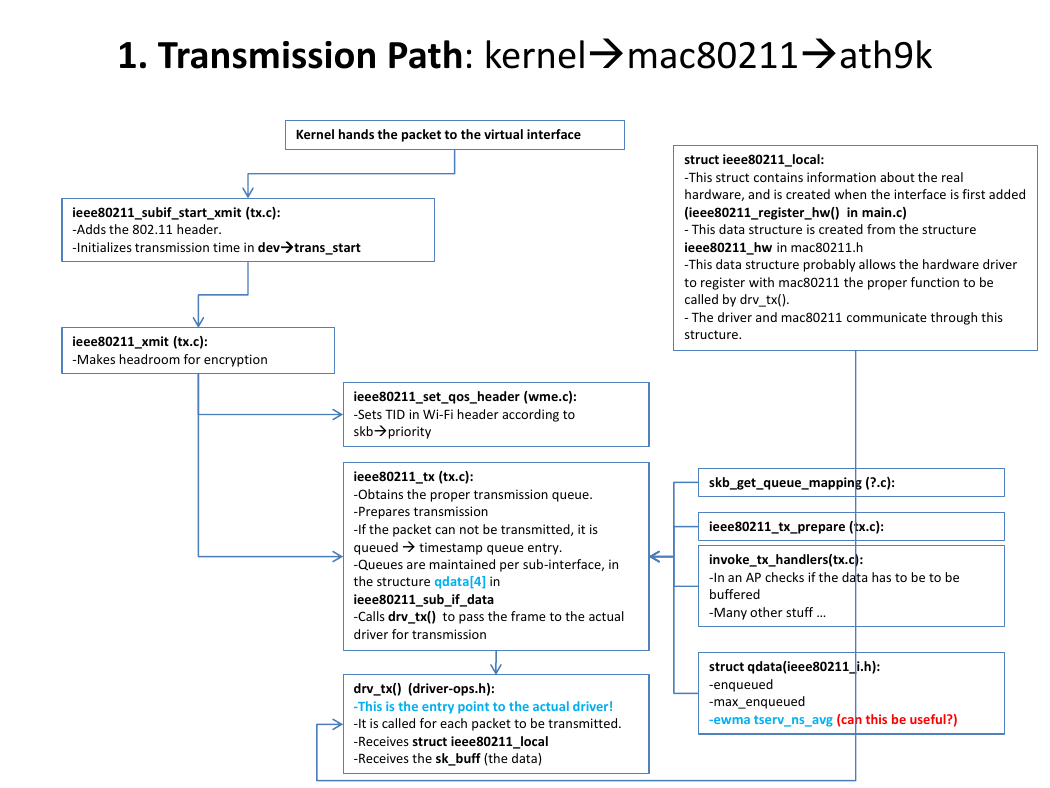
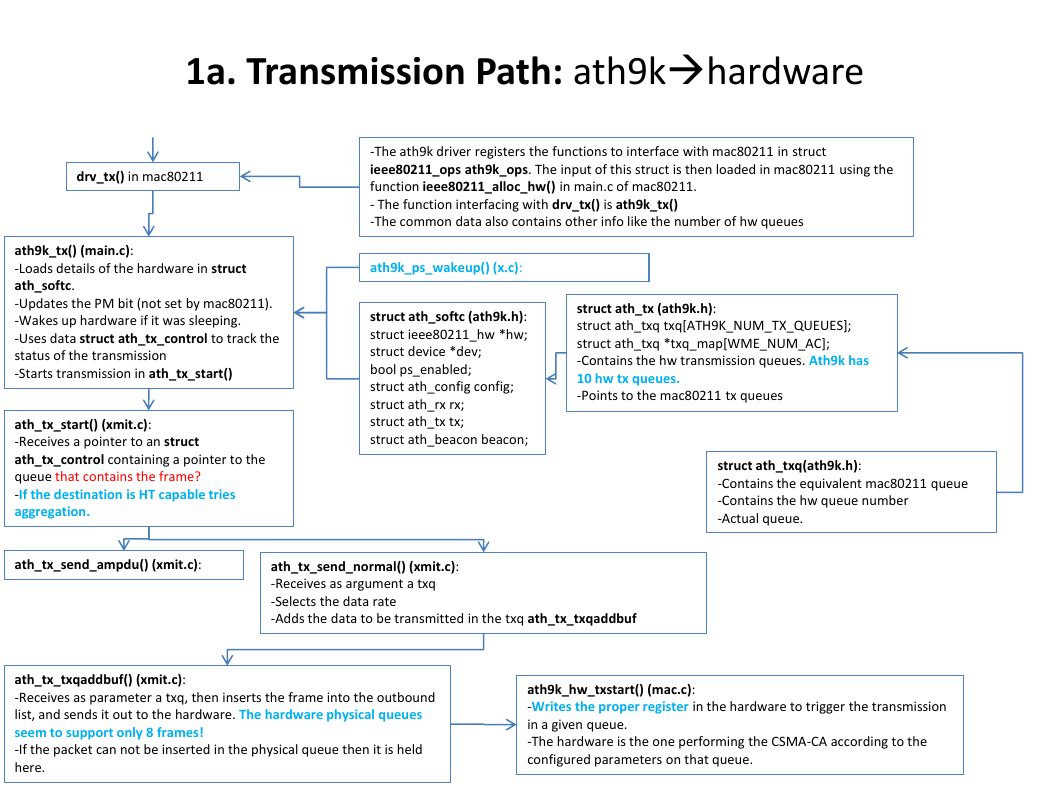
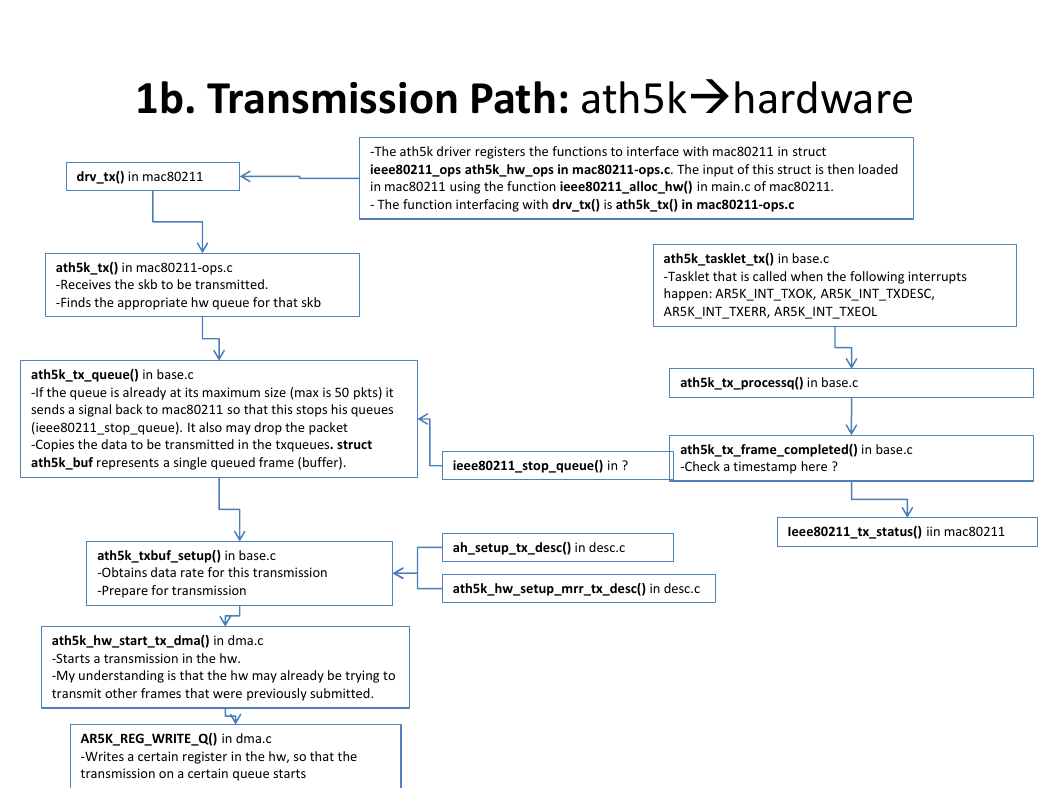
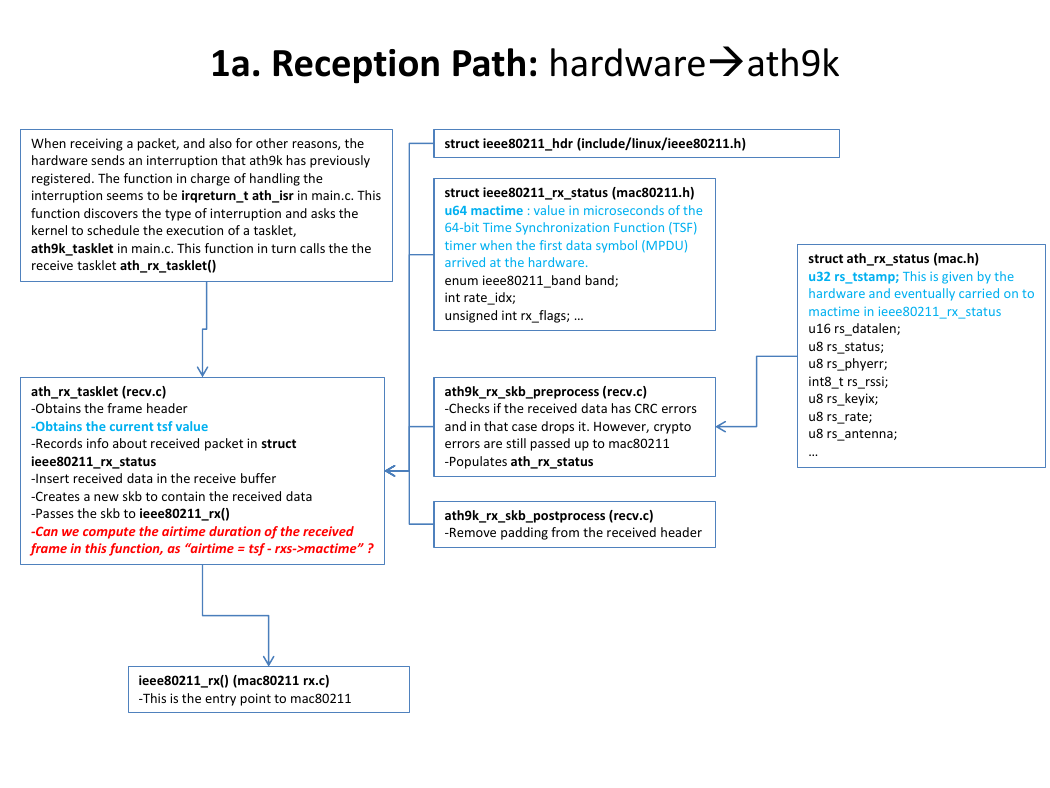
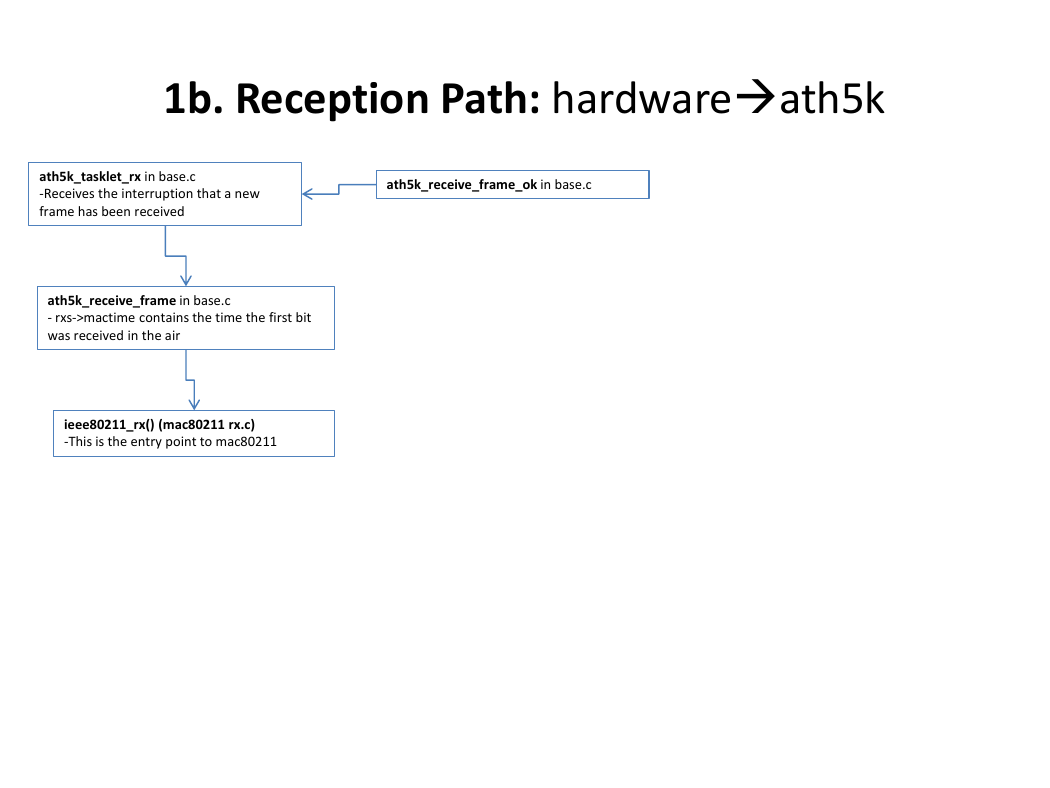
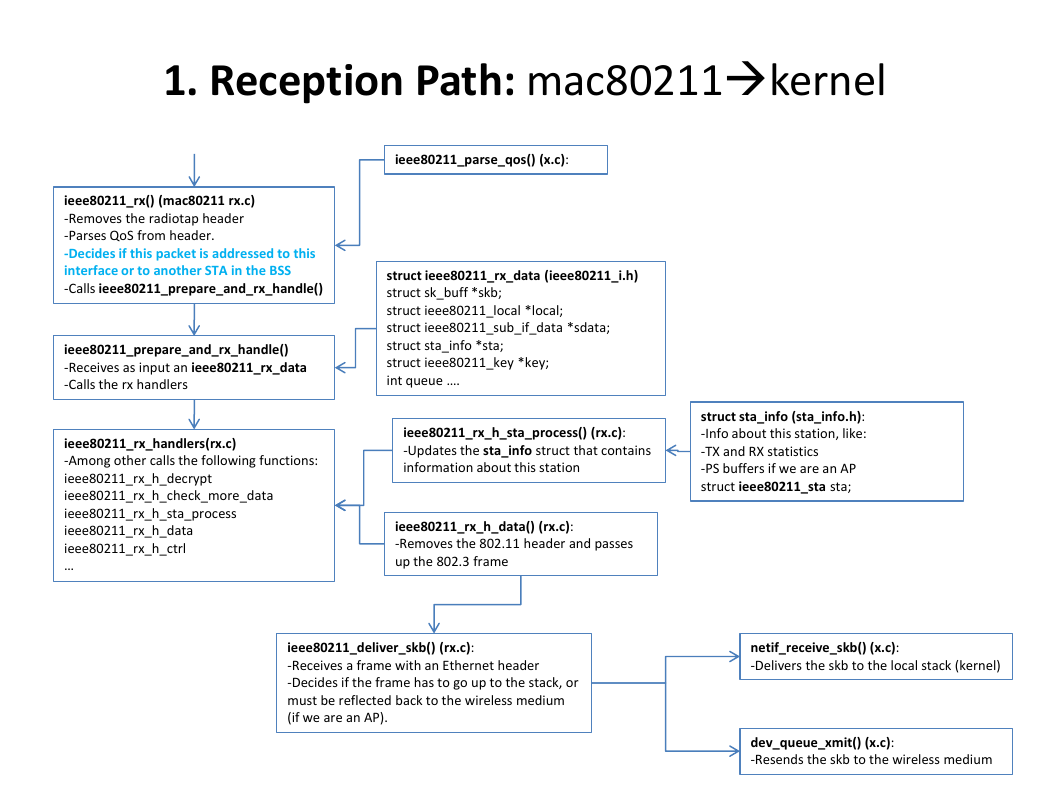








 2023年江西萍乡中考道德与法治真题及答案.doc
2023年江西萍乡中考道德与法治真题及答案.doc 2012年重庆南川中考生物真题及答案.doc
2012年重庆南川中考生物真题及答案.doc 2013年江西师范大学地理学综合及文艺理论基础考研真题.doc
2013年江西师范大学地理学综合及文艺理论基础考研真题.doc 2020年四川甘孜小升初语文真题及答案I卷.doc
2020年四川甘孜小升初语文真题及答案I卷.doc 2020年注册岩土工程师专业基础考试真题及答案.doc
2020年注册岩土工程师专业基础考试真题及答案.doc 2023-2024学年福建省厦门市九年级上学期数学月考试题及答案.doc
2023-2024学年福建省厦门市九年级上学期数学月考试题及答案.doc 2021-2022学年辽宁省沈阳市大东区九年级上学期语文期末试题及答案.doc
2021-2022学年辽宁省沈阳市大东区九年级上学期语文期末试题及答案.doc 2022-2023学年北京东城区初三第一学期物理期末试卷及答案.doc
2022-2023学年北京东城区初三第一学期物理期末试卷及答案.doc 2018上半年江西教师资格初中地理学科知识与教学能力真题及答案.doc
2018上半年江西教师资格初中地理学科知识与教学能力真题及答案.doc 2012年河北国家公务员申论考试真题及答案-省级.doc
2012年河北国家公务员申论考试真题及答案-省级.doc 2020-2021学年江苏省扬州市江都区邵樊片九年级上学期数学第一次质量检测试题及答案.doc
2020-2021学年江苏省扬州市江都区邵樊片九年级上学期数学第一次质量检测试题及答案.doc 2022下半年黑龙江教师资格证中学综合素质真题及答案.doc
2022下半年黑龙江教师资格证中学综合素质真题及答案.doc